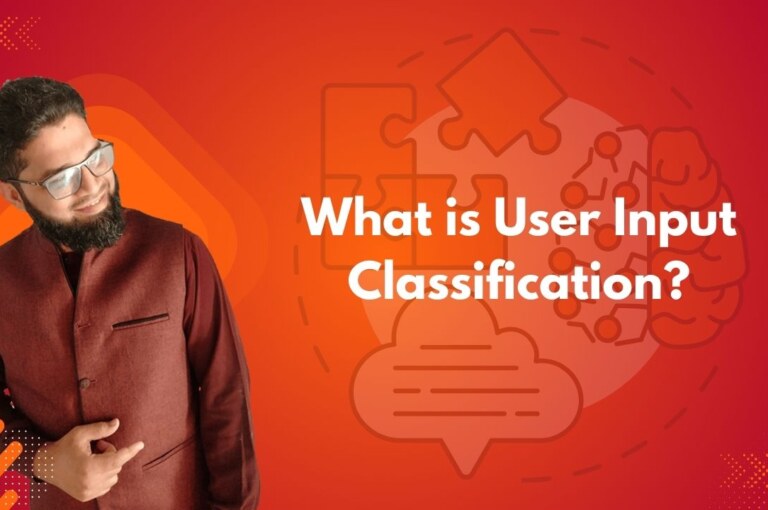User Input Classification is the process of identifying what a user wants based on the text or voice input they provide. It helps systems—like chatbots, websites, or virtual assistants—understand whether the user is asking a question, giving a command, offering feedback, or making a request.
Simply put: It’s how machines figure out “What is the user trying to do?”
This process is often combined with techniques such as query phrasification, natural language processing, and semantic relevance to deliver smarter and more context-aware responses.
Key Concepts Behind User Input Classification
Natural Language Processing (NLP)
At the heart of input classification is NLP, which helps machines understand human language. NLP breaks down the input’s words, structure, and meaning to decide what type of input it is.
Example:
“What is the weather today?” = Recognized as a weather-related query
Intent Recognition
This involves detecting the user’s intention behind the message.
Examples:
- “Book a flight” → Service request
- “What time is my flight?” → Information inquiry
Entity Extraction
Entities are key details like names, dates, locations, or products. Identifying them helps the system complete the task.
Example:
“Book a flight to New York on Monday”
- New York = Destination
- Monday = Date
Machine Learning and Training
Machine learning models learn from large datasets containing user inputs and responses. Over time, they recognize patterns and improve accuracy.
This allows systems to adapt to different types of queries.
Contextual Understanding
Some inputs depend on previous interactions. Systems that remember earlier questions can better understand what the user means now.
Example:
- First: “Book a flight to New York”
- Then: “When does it leave?”
The system understands the user is referring to that same flight.
Applications of User Input Classification
Chatbots & Virtual Assistants
Chatbots like Alexa, Siri, or Google Assistant use input classification to understand your commands and respond correctly.
Example:
- “Set an alarm for 7 AM” → Action = Set alarm
- Extracted entity = 7 AM
Customer Support Systems
Input classification routes customer queries to the right support team.
Example:
- “I need help with billing” → Sent to the billing team
- “Where’s my order?” → Triggers order tracking
Search Engines
Search engines classify queries into categories like:
- Informational (“What is SEO?”)
- Navigational (“YouTube login”)
- Transactional (“Buy shoes online”)
This improves the relevance of search results.
Personalized Recommendations
Streaming platforms and online stores use classification to understand preferences.
Example:
“I want to watch action movies” → Returns action movie suggestions
Voice-Controlled Devices
Devices like Google Home or Amazon Echo rely on classification to respond to spoken commands.
“Turn off the lights” → Recognized as a device control command
Healthcare and Fitness Apps
Apps categorize user inputs to deliver health suggestions or log data.
- “I feel dizzy” → Interpreted as a symptom
- “Log my dinner” → Triggers a meal entry action
Benefits of User Input Classification
- Better Accuracy: Improves system response precision
- Fast Execution: Triggers the correct action quickly
- Scalable Automation: Handles thousands of queries at once
- Personalized Experience: Suggests content tailored to user needs
Challenges in Input Classification
Ambiguity & Variability
People express the same intent in many ways.
“What’s the time?”
- May need location to give the correct answer
- Lacks context if used alone
Multi-turn Conversations
Keeping track of long chats and earlier questions can confuse systems.
- “Book a flight.”
- “What time is it again?”
The system must link both inputs correctly.
Language & Dialects
Different users may type or speak in:
- Local dialects
- Slang
- Multiple languages
These make classification more complex.
Wrap Up
User Input Classification is the secret behind smooth conversations with your devices, apps, or websites. It enables systems to:
- Understand what users really mean
- Respond with relevant and helpful answers
- Improve continuously with machine learning
- Offer a personalized, fast, and intuitive experience
As systems become more intelligent, accurate input classification will be key to delivering seamless and human-like interactions across industries.
Want to Go Deeper into SEO?
Explore more from my SEO knowledge base:
▪️ SEO & Content Marketing Hub — Learn how content builds authority and visibility
▪️ Search Engine Semantics Hub — A resource on entities, meaning, and search intent
▪️ Join My SEO Academy — Step-by-step guidance for beginners to advanced learners
Whether you’re learning, growing, or scaling, you’ll find everything you need to build real SEO skills.
Feeling stuck with your SEO strategy?
If you’re unclear on next steps, I’m offering a free one-on-one audit session to help and let’s get you moving forward.





Leave a comment